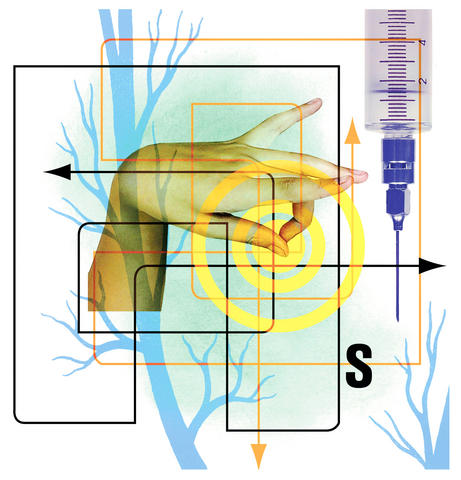When it comes to understanding, preventing and treating chronic diseases, multiple sclerosis (MS) ranks among the most challenging. The word "multiple" is apt in more ways than one.
Various suggested causes include early-life exposure to certain viruses or toxic agents, geographic and dietary influences, inherent immunological defects and underlying genetic susceptibilities.
MS is highly unpredictable. Rarely are any two patients alike in the presentation, duration and progression of symptoms; even the underlying cause of disability in MS is being reconsidered. And rarely do any two patients respond in the same way to a given therapy, be it medically established or alternative. Trial and error is the name of the game, experts say, because it is often not possible to know in advance what will work best for individual patients.

ILLUSTRATION: NY TIMES NEWS SERVICE
These are the frequent underpinnings of confusion and distrust among those afflicted and their families. They sometimes give rise to claims that the organizations raising large amounts of money to support research and patient services and the scientists studying the disease have no intention of finding a cure, lest it put them out of business. It is a ridiculous notion on its face, since many of those involved in fundraising and research have watched loved ones suffer and succumb to diseases like MS.
The failure of the medical establishment to solve mysteries like MS also prompts many patients to seek alternative remedies suggested by friends and relatives or found on the Internet. Many of these remedies are harmless, and some may actually be helpful, at least for a time. But when the remedies keep patients from trying the best that modern medicine can offer - or when they interact negatively with established remedies - the result can be a far more rapid downhill course than might otherwise have occurred.
The goal, then, for those considering alternative treatments is to make them complementary to, not competitive with, therapies that have passed muster in well-designed clinical trials.
"People have only one brain and one spinal cord, and what everyone with MS should be doing is optimizing treatment options every single day," said Allen Bowling, a neurologist at the Rocky Mountain MS Center and author of Complementary and Alternative Medicine and Multiple Sclerosis. "Every patient should play the chips for which we have the best evidence. They should take advantage of what conventional medicine has to offer along with unconventional medicine," as long as the latter does not interfere with the former.
TREATMENT OPTIONS
MS is an inflammatory autoimmune disease of the central nervous system in which the body's own immune system attacks the myelin sheath that insulates nerves in the brain and spinal cord, resulting in irreversible damage to the axons that transmit nervous-system signals. About 400,000 people in the US are affected, twice as many women as men.
MS is typically diagnosed between ages 20 and 40, but evidence indicates that it starts years before the first symptoms of weakness or disability appear. Even without a cure, many treatments are available - like drugs, physical and occupational therapy, exercise and rest - that can ease symptoms and delay the disease's progression.
In most patients, the disease starts out, and may stay indefinitely, in a relapsing-remitting form that results in gradual progressive disability but is rarely life-threatening. In about 10 percent of patients, the disease is progressive from the outset and life expectancy is reduced.
The goal of therapy is to prevent relapses and the worsening of symptoms. Since symptoms can disappear on their own, large, long-term, scientifically controlled clinical trials are needed to determine what works and what only seems to work initially. Trials are also needed to uncover potentially serious side effects.
Such trials have identified half a dozen substances called immune modulators, five of which have been approved by the Food and Drug Administration as disease-modifying agents. These are Avonex, Betaseron, Copaxane, Novantrone and Rebif.
In her book Multiple Sclerosis: An Essential Guide for the Newly Diagnosed, Margaret Blackstone, a medical writer and MS patient, describes Avonex, Betaseron and Rebif as interferon-based treatments administered by injection, which seek to calm an overactive immune system. Copaxane, also taken by injection, is an antigen that fools the body into thinking it is the protein in myelin. It is meant to protect the myelin from an immunological attack. Novantrone is an immunosuppressive cancer drug used to treat progressive MS.
A sixth drug, Tysabri, a monoclonal antibody that prevents immune cells from entering the brain, is given intravenously every four weeks. Tysabri was removed from the market in 2004 because of serious complications in three patients. It is now back in clinical trials and available through a special program to those who had found it to be the best treatment for their disease, but last week its makers posted a warning to doctors that it has been found to cause serious liver damage in some patients.
THERAPY AND ALTERNATIVES
Up to 20 percent of patients have a relatively mild form of MS and may not need drug treatment, but it is impossible to predict who they are. Bowling emphasized the importance of not waiting until neurological defects appear, since they cannot be reversed by any known therapy. He also said therapies should be tailored to the nature of each patient's disease and the known activity of the various drugs.
Blackstone states that it is important for patients to recognize an impending relapse - common indicators are fatigue and "a heightened sense of vulnerability, as if the person can tell something bad is going to happen" - and not try to work through a relapse. "It's better to rest" and "avoid engaging in strenuous activity," she suggests.
If relapse symptoms warrant, corticosteroids can be used to speed recovery and possibly to delay or prevent another relapse. The other critically important aspect of therapy involves managing symptoms. Depending upon the stage and severity of the disease, symptoms may include fatigue, dizziness, vision changes, spasticity, weakness, tremor, numbness, balance problems, pain, depression, constipation and speech difficulties. In more advanced disease, sexual problems and incontinence are common.
Measures may be taken to reduce disability from these symptoms, like physical, occupational and speech therapy and psychotherapy; avoiding heat; getting adequate rest; and learning to listen to one's limitations.
At one point or another, most MS patients also seek out, and often benefit from,
complementary and alternative medicine, like acupuncture, dietary supplements, biofeedback, meditation, guided imagery, tai chi, cooling therapy, yoga, therapeutic touch and electromagnetic therapy. In his book, Bowling describes what is known about each of these possible adjuncts to medically established treatments, some of which can be counter-
productive or negate the benefits of medication.

The unexpected collapse of the recall campaigns is being viewed through many lenses, most of them skewed and self-absorbed. The international media unsurprisingly focuses on what they perceive as the message that Taiwanese voters were sending in the failure of the mass recall, especially to China, the US and to friendly Western nations. This made some sense prior to early last month. One of the main arguments used by recall campaigners for recalling Chinese Nationalist Party (KMT) lawmakers was that they were too pro-China, and by extension not to be trusted with defending the nation. Also by extension, that argument could be

Aug. 4 to Aug. 10 When Coca-Cola finally pushed its way into Taiwan’s market in 1968, it allegedly vowed to wipe out its major domestic rival Hey Song within five years. But Hey Song, which began as a manual operation in a family cow shed in 1925, had proven its resilience, surviving numerous setbacks — including the loss of autonomy and nearly all its assets due to the Japanese colonial government’s wartime economic policy. By the 1960s, Hey Song had risen to the top of Taiwan’s beverage industry. This success was driven not only by president Chang Wen-chi’s

Last week, on the heels of the recall election that turned out so badly for Taiwan, came the news that US President Donald Trump had blocked the transit of President William Lai (賴清德) through the US on his way to Latin America. A few days later the international media reported that in June a scheduled visit by Minister of National Defense Wellington Koo (顧立雄) for high level meetings was canceled by the US after China’s President Xi Jinping (習近平) asked Trump to curb US engagement with Taiwan during a June phone call. The cancellation of Lai’s transit was a gaudy

The centuries-old fiery Chinese spirit baijiu (白酒), long associated with business dinners, is being reshaped to appeal to younger generations as its makers adapt to changing times. Mostly distilled from sorghum, the clear but pungent liquor contains as much as 60 percent alcohol. It’s the usual choice for toasts of gan bei (乾杯), the Chinese expression for bottoms up, and raucous drinking games. “If you like to drink spirits and you’ve never had baijiu, it’s kind of like eating noodles but you’ve never had spaghetti,” said Jim Boyce, a Canadian writer and wine expert who founded World Baijiu Day a decade